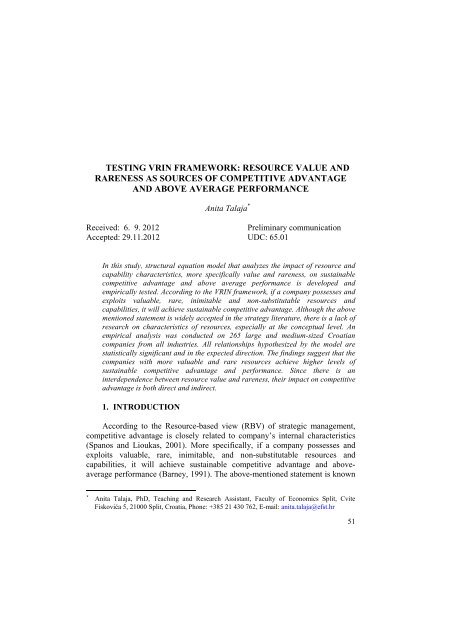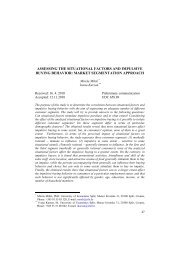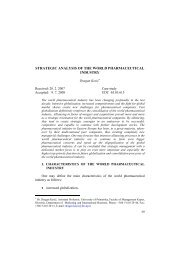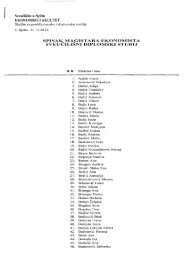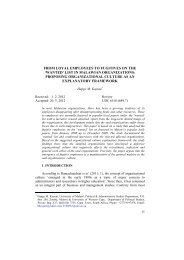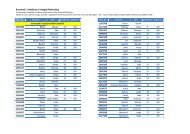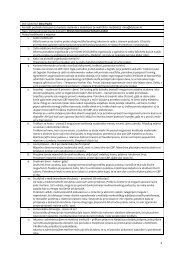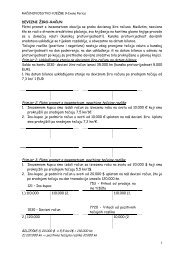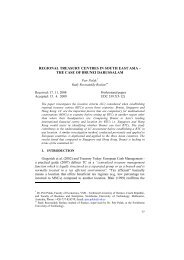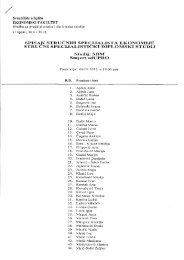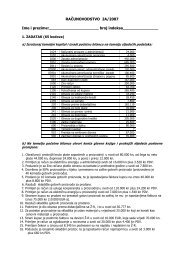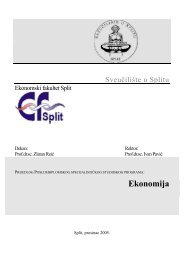TESTING VRIN FRAMEWORK: RESOURCE VALUE AND ...
TESTING VRIN FRAMEWORK: RESOURCE VALUE AND ...
TESTING VRIN FRAMEWORK: RESOURCE VALUE AND ...
- No tags were found...
You also want an ePaper? Increase the reach of your titles
YUMPU automatically turns print PDFs into web optimized ePapers that Google loves.
<strong>TESTING</strong> <strong>VRIN</strong> <strong>FRAMEWORK</strong>: <strong>RESOURCE</strong> <strong>VALUE</strong> <strong>AND</strong>RARENESS AS SOURCES OF COMPETITIVE ADVANTAGE<strong>AND</strong> ABOVE AVERAGE PERFORMANCEAnita Talaja *Received: 6. 9. 2012Preliminary communicationAccepted: 29.11.2012 UDC: 65.01In this study, structural equation model that analyzes the impact of resource andcapability characteristics, more specifically value and rareness, on sustainablecompetitive advantage and above average performance is developed andempirically tested. According to the <strong>VRIN</strong> framework, if a company possesses andexploits valuable, rare, inimitable and non-substitutable resources andcapabilities, it will achieve sustainable competitive advantage. Although the abovementioned statement is widely accepted in the strategy literature, there is a lack ofresearch on characteristics of resources, especially at the conceptual level. Anempirical analysis was conducted on 265 large and medium-sized Croatiancompanies from all industries. All relationships hypothesized by the model arestatistically significant and in the expected direction. The findings suggest that thecompanies with more valuable and rare resources achieve higher levels ofsustainable competitive advantage and performance. Since there is aninterdependence between resource value and rareness, their impact on competitiveadvantage is both direct and indirect.1. INTRODUCTIONAccording to the Resource-based view (RBV) of strategic management,competitive advantage is closely related to company’s internal characteristics(Spanos and Lioukas, 2001). More specifically, if a company possesses andexploits valuable, rare, inimitable, and non-substitutable resources andcapabilities, it will achieve sustainable competitive advantage and aboveaverageperformance (Barney, 1991). The above-mentioned statement is known*Anita Talaja, PhD, Teaching and Research Assistant, Faculty of Economics Split, CviteFiskovića 5, 21000 Split, Croatia, Phone: +385 21 430 762, E-mail: anita.talaja@efst.hr51
Management, Vol. 17, 2012, 2, pp. 51-64A. Talaja: Testing <strong>VRIN</strong> framework: Resource value and rareness as sources of competitive…in strategic literature ad <strong>VRIN</strong> framework. Although the RBV is one of themost influential theories of strategic management, it has received only modestsupport that varies considerably with the independent variable and theoreticalapproach employed. There is a lack of research on characteristics of resources,particularly value and rareness Newbert (2007, 2008). As emphasized by Priemand Butler (2001), to infer that resources and capabilities are valuable and raresimply because they are related to competitive advantage is to assume that<strong>VRIN</strong> hypotheses that link resource characteristics to competitive advantage arefactual and do not require any empirical confirmation. These hypotheses are infact purely theoretical and for them to be supported an empirical investigation isnecessary (Priem and Butler, 2001; Newbert, 2008).Nevertheless, only few empirical studies examine <strong>VRIN</strong> resourcecharacteristics at the conceptual level (Spanos and Lioukas, 2001; Newbert,2007). Furthermore, the dependent variable of the RBV, competitive advantage,although widely mentioned in strategic management, is not precisely defined.Moreover, the terms performance and competitive advantage are often used assynonyms. The following section presents the theoretical background of the twoconcepts analyzed: competitive advantage and <strong>VRIN</strong> framework, as well astheoretical propositions and hypothesis. Subsequent sections present empiricalanalysis and results.2. THE <strong>RESOURCE</strong> BASED THEORY OF COMPETITIVEADVANTAGEThe term competitive advantage was first introduced by Michael Porter(1985) in his competitive strategies analysis. According to Porter (1985),competitive advantage stems from the company's ability to create value for itsbuyers that will exceed the cost of its creation. Value is what buyers are willingto pay, and superior value stems from offering lower prices than competitors forsimilar benefits or unique benefits at a higher price. According to Barney(1991), company has a competitive advantage when it is implementing a valuecreating strategy different from the strategies of its competitors. Peteraf (1993)defines competitive advantage as sustainable above-normal returns which canbe achieved only if four prerequisites (resource heterogeneity, ex post limits tocompetition, imperfect mobility and ex ante limits to competition) are met. Onthe other hand, Grant (2002) believes that the company has a competitiveadvantage when it earns a higher level of profits than its competitors. Foss andKnudsen (2003) stress that the two main definitions of competitive advantage(Barney, 1991; Peteraf, 1993) are not related because a company cancontinuously implement a unique strategy based on the resource acquired in a52
Management, Vol. 17, 2012, 2, pp. 51-64A. Talaja: Testing <strong>VRIN</strong> framework: Resource value and rareness as sources of competitive…competitive market and thus, according to Barney, possess a sustainablecompetitive advantage, however, at the same time, it can generate only anaverage, normal profit, which means that, according to Peteraf (1993), there isno sustainable competitive advantage. As a response to Foss and Knudesen's(2003) critique, Peteraf and Barney (2003) provide definition of competitiveadvantage that is consistent with those by Porter (1985), Barney (1991) andPeteraf (1993). According to Peteraf and Barney (2003), a company hascompetitive advantage when it is able to create greater economic value.Economic value is defined as the difference between the perceived benefitsgained by the buyers and the economic cost to the company. There are multipleways of achieving competitive advantage, which means that, to achieve it, acompany does not have to be the best in all dimensions, but it must be superiorin value creation (Peteraf and Barney, 2003).The resource-based view (RBV), as one of the most widely acceptedtheories of competitive advantage, focuses on relationships between company’sinternal characteristics and competitive advantage (Spanos and Lioukas, 2001).It is based on the assumption that companies within an industry areheterogeneous in terms of resources they control. Since resources may not beperfectly mobile, heterogeneity can be long lasting (Barney, 1991). Accordingto Barney (1992, 1995) resources and capabilities include financial, physical,human and organizational assets that a company uses to develop, manufactureand deliver products and services to customers. Financial resources includedebt, equity, retained earnings, etc. Physical resources include machines,manufacturing plants and buildings. Human resources relate to the skills,knowledge, ability to make judgments, risk-taking propensity and wisdom ofindividuals associated with the company. Organizational resources are history,connections, confidence, organizational structure, formal reporting structure,management control systems and compensation policies (Barney, 1992, 1995).Barney (1991) develops the so-called <strong>VRIN</strong> framework which definescharacteristics resources need to posses in order to enable competitiveadvantage to be achieved. According to <strong>VRIN</strong> framework, valuable, rare,imperfectly imitable and not substitutable resources have the potential forcreating sustainable competitive advantage. The value of resources lies in theirability to neutralize threats and enable company to exploit opportunities thatarise in a business environment, i.e. resources are valuable if they enable acompany to design and implement strategies that improve its efficiency andeffectiveness. It is important to emphasize that the value of resources has to beestimated in the context of corporate strategy and the specific environment inwhich the company operates. Resource rareness implies that competitors do not53
Management, Vol. 17, 2012, 2, pp. 51-64A. Talaja: Testing <strong>VRIN</strong> framework: Resource value and rareness as sources of competitive…have access to the particular resource, or that they have only limited access.Valuable resources that are not rare cannot be the sources of the competitiveadvantage. To achieve the competitive advantage, resource must be valuableand rare. However, this does not mean that valuable resources that are not rareare irrelevant to a company. These resources ensure the survival of the companyand enable it to achieve competitive parity in the industry in which it operates.If a company fails to exploit valuable resources, it will have the competitivedisadvantage. If the resource that a company possesses is not valuable, then itwill not allow the company to choose and implement strategies that exploitopportunities and neutralize threats from the environment. Such resources areconsidered as weaknesses. Valuable resources that are not rare are consideredstrengths (Barney and Clark, 2007). Resources are imperfectly imitable ifcompetitors cannot obtain them on a particular market. If there is no otherresource that could be used as an adequate and worthy replacement for theexisting resource, existing resources are not substitutable. It is stressed that thevalue and rarity of resources are necessary conditions for achieving competitiveadvantage. However, for achieving sustainable competitive advantage,resources also have to be imperfectly imitable and not substitutable. Foss andKnudsen (2003) reflect on Barney’s classification of <strong>VRIN</strong> conditions, and statethat there are the only two necessary conditions for achieving sustainablecompetitive advantage: uncertainty and immobility.Although the RBV is considered one of the most influential theories ofstrategic management (Powell, 2001; Priem and Butler, 2001; Newbert, 2008),its acceptance seems to be based more on the basis of logic and intuition than onthe empirical evidence (Newbert, 2008). In most studies that examine theconnection between company’s resources and performance, resourceheterogeneity approach is employed. By that approach, specific resource orcapability is claimed to be valuable, rare, imperfectly imitable or nonsubstitutable,and then the amount of that resource or capability that a companyowns is correlated with competitive advantage or performance (Newbert, 2007,2008). This type of research provides evidence that a specific resource can helpcompany to achieve competitive advantage, but does not verify the influence ofresource characteristics (value, rareness, inimitability and non-substitutability)on competitive advantage (Newbert, 2008).Results of studies using the resource heterogeneity approach suggest thatcompany’s asset influences market performance, but not profitability (Spanosand Lioukas, 2001), company-specific resources (corporate managementcapabilities, employee value-added and technological competence) enhanceaccounting-based and market-based measures of performance (Acquaah and54
Management, Vol. 17, 2012, 2, pp. 51-64A. Talaja: Testing <strong>VRIN</strong> framework: Resource value and rareness as sources of competitive…Chi, 2007) and that relationships between resource sustainability, capabilitydynamism and resource orientation (RO) are significant (Chmielewski andPaladino, 2007). Wu (2010) divided resources in two groups, <strong>VRIN</strong> and non-<strong>VRIN</strong>, and concluded that groups are positively correlated to competitiveadvantage in low and medium volatility environments, but in high volatilityenvironments, only <strong>VRIN</strong> resources have influence on competitive advantage.Only several studies test resource characteristics at the conceptual level.Such studies include Markman, Espina and Phan (2004), who came to theconclusion that competitive advantage is related to inimitability, but notsubstitutability of patents, and Newbert (2008), who found that value andrareness are related to competitive advantage. He also pointed that there is apaucity of conceptual-level studies, particularly with respect to characteristicsof value and rareness. After testing the relationship between resource value andcompetitive advantage (Talaja, 2012a) and the relationship between resourcerareness and company’s performance (Talaja, 2012b), based on previous results,an integrated model of resource value, rareness, competitive advantage andperformance (Figure 1) is presented with the aim of confirming proposedrelationships, as well as testing resource value and rareness at the conceptuallevel.Figure 1 shows that company's competitive advantage is determined by thevalue and rareness of its resources and capabilities. Considering that resourcevalue and rareness are interdependent, they influence competitive advantagedirectly and indirectly.Valuable Valuable resourcesand resources capabilities andH5H1H2H3CompetitiveadvantageH4PerformanceRare resources andcapabilitiesH6direct relationshipindirect relationshipFigure 1. Value, rareness and company performance55
Management, Vol. 17, 2012, 2, pp. 51-64A. Talaja: Testing <strong>VRIN</strong> framework: Resource value and rareness as sources of competitive…Competitive advantage is operationalized separately from company’sperformance, and it is assumed that it determines company's performance levelsand mediates the relationship between resource rareness and performance, aswell as the relationship between resource value and performance.Model from Figure 1 can be presented through the following hypothesesthat will be tested in subsequent chapters:H1: Value and rareness of company’s resources and capabilities arepositively related.H2: If a company possesses valuable resources and capabilities, it willachieve sustainable competitive advantage.H3: If a company possesses rare resources and ca-pabilities, it will achievesustainable competitive advantage.H4: Sustainable competitive advantage leads to above averageperformance levels.H5: Companies with more valuable resources and capabilities will achievehigher performance levels.H6: Companies with rare resources and capabilities will achieve higherperformance levels.3. SAMPLE <strong>AND</strong> MEASURESIn this study, primary data collected from large and medium-sized Croatiancompanies with more than 100 employees is used. Such companies wereidentified using the data from the Croatian Chamber of Economy, resulting in apopulation of 1,017 companies. The study simultaneously employed online andmail survey. E-mail invitations containing a hyperlink to a web site with theonline survey were sent to top managers in sample companies. A mail surveywas sent at the same time, so respondents were able to choose the way theywanted to participate. A total of 265 usable surveys were collected, whichresulted with the response rate of 26.06%, acceptable for this type of research(Drnevich and Kriauciunas, 2011; Protogerou, Caloghirou and Lioukas, 2008).From 265 usable questionnaires, 144 (54.3%) were collected through mailsurvey, while 121 (45.7%) were collected via online survey. In addition, thereare 108 (40.8%) large, and 157 (59.2%) middle-sized companies in the sample,56
Management, Vol. 17, 2012, 2, pp. 51-64A. Talaja: Testing <strong>VRIN</strong> framework: Resource value and rareness as sources of competitive…of which 46 (17.4%) companies are in the foreign and 219 (82.6%) in thedomestic ownership.According to Makadok (2001), no matter how outstanding company’scapabilities are, they do not generate economic profits if the company fails toacquire the resources which will enhance the productivity of these capabilities.Similarly, Newbert (2008) argues that even if a company possesses resourcesthat have the potential to create competitive advantage, that potential will not berealized if the company does not possess capabilities for resource exploitation.Therefore, Newbert (2008) does not examine the characteristics of individualresources and capabilities, but the characteristics of relevant groups of resourcesand capabilities of enterprises. In the operationalization of valuable resourcesand capabilities, recommendations from Makadok (2001) and Newbert (2008)are adopted, as well as previously mentioned Barney’s (1992, 1995) definitionand classification of resources and capabilities.This means that value, or contribution in neutralizing threats and exploitingopportunities that arise in a business environment of physical (VA_PH), human(VA_HU), organizational (VA_OR) intellectual (VA_IN) and financial(VA_FI) resources and capabilities is examined. In addition, rareness ofphysical (RA_PH), human (RA_HU), organizational (RA_OR), intellectual(RA_IN) and financial (RA_FI) resources and capabilities is analyzed. Both,value and rareness, were assessed on a five-point scale ranging from 1 = not atall to 5 = entirely.Competitive advantage is operationalized through manager’s perceptionsof the company's success in comparison to major competitors, according to thefollowing elements: a general advantage (or disadvantage) over competitors(CA1); sustainability of acquired advantage (CA2); the product/service qualityand image (CA3); price of products/services (CA4); the production cost ofproduct or cost of service delivery (CA5) and customer satisfaction withproduct/service (CA6), that are in accordance with the definition of competitiveadvantage given by Peteraf and Barney (2003). The scale was assessed on afive-point Likert-type scale ranging from 1 (much worse than competitors) to 5(much better than competitors).Performance is operationalized through managers’ perceptions of mainperformance categories: sales (PERF1); sales growth (PERF2); profitability(PERF3); market share (PERF4), increase in market share (PERF5) andsustainability of achieved performance (PERF6), given that the perceptualmeasures of performance correlate with objective measures (Powell, 1992).57
Management, Vol. 17, 2012, 2, pp. 51-64A. Talaja: Testing <strong>VRIN</strong> framework: Resource value and rareness as sources of competitive…4. RESULTSFor statistical analysis, Lisrel 8.80 structural modeling program withSattora-Bentler robust Maximum Likelihood approach (RML) was used. TheRML method was chosen because it provides an overall model fit test statisticsand parameter standard errors that are robust to mild deviations from normality(Raykov and Marcoulides, 2006). SEM analysis of proposed recursive structuralmodel was conducted in one step. The model consists of two exogenous latentconstructs: resource value and resource rareness, two endogenous latentconstructs: competitive advantage and performance, and 22 manifest variables,which serve as indicators of latent variables. From t-values of factor loadingsand path coefficients presented in Figure 2, it can be seen that all relationshipsare statistically significant.Figure 2. Structural equation model - t-valuesSource: Empirical analysis results (Lisrel output).58
Management, Vol. 17, 2012, 2, pp. 51-64A. Talaja: Testing <strong>VRIN</strong> framework: Resource value and rareness as sources of competitive…Factor loadings and estimated path coefficients for the structuralrelationships hypothesized by the model are presented in Figure 3. The resultsshow that all paths are in the expected direction.Figure 3: Structural equation model - standardized solutionSource: Empirical analysis results (Lisrel output).Direct effects of resource value and rareness on company's competitiveadvantage, as well as direct effect of competitive advantage on performance, areall shown in Figure 1, while indirect and total effects, which are a function ofdirect effects that make them up, are shown in Table 1.Table 1. Direct, indirect and total effects from the proposed modelDirectinfluence oncompetitiveadvantageIndirectinfluence oncompetitiveadvantageOverallinfluence oncompetitiveadvantageInfluence onperformanceValue 0.32 0.171 0.491 0.397Rareness 0.31 0.176 0.486 0.394Source: Empirical analysis results.59
Management, Vol. 17, 2012, 2, pp. 51-64A. Talaja: Testing <strong>VRIN</strong> framework: Resource value and rareness as sources of competitive…From Figure 2 and 3, it can be seen that hypotheses H1, H2, H3 and H4are all supported since relationships between latent variables are statisticallysignificant (Figure 2), in the expected direction, i.e. positive (Figure 3) andnontrivial. The direct effect of resource value on competitive advantage equals0.32, while the direct effect of resource rareness on competitive advantage is0.31. The interdependence between resource value and rareness equals 0.55,while the effect of competitive advantage on company's performance is 0.81. InTable 1, the strengths of indirect relationships hypothesized by H5 and H6 arecalculated.From Table 1, it can be seen that the indirect effect of resource value oncompetitive advantage equals 0.171, which means that the total effect is 0.491.The indirect effect of resource rareness on competitive advantage is 0.176, andthe total effect equals 0.486. Resource value has an indirect influence onperformance that equals 0.397. Resource rareness has an indirect impact oncompany's performance (through competitive advantage) that equals 0.394.Since the effect of resource value and rareness on performance is statisticallysignificant (since all including paths are statistically significant), positive aspredicted, and nontrivial, it can be concluded that hypotheses H5 and H6 areconfirmed.Since the asymptotic covariance matrix that is necessary for RMLestimation is calculated under listwise deletion, only Root Mean Square Error ofApproximation (RMSEA) for overall model fit is given. With RMSEA =0.0892, the model has acceptable fit. Convergent validity of the proposedmeasurement theory is also examined. The manifest variables that are theindicators of a specific construct should have a high proportion of variance incommon, known as convergent validity. The relative amount of convergentvalidity among item measures is estimated though analyzing constructreliability (CR). In the case of high convergent validity, CR should be higherthan 0.6 (Hair, 2005). Construct reliability for latent variables is presented inTable 2.Table 2. Construct reliability of latent variablesConstructreliability (CR)Value (va)Rareness(ra)Competitiveadvantage (ca)Performance(perf)0.565 0.744 0.794 0.881Source: Empirical analysis results.60
Management, Vol. 17, 2012, 2, pp. 51-64A. Talaja: Testing <strong>VRIN</strong> framework: Resource value and rareness as sources of competitive…From Table 2, it can be seen that construct reliability (CR) for resourcerareness, competitive advantage and performance is acceptable, i.e. higher than0.6, while CR for resource value is slightly under 0.6 (CR=0.565).5. CONCLUSIONThis study provides an empirical test of main resource-based viewpropositions. The results show that valuable and rare resources significantlyaffect company's competitive advantage and performance. The model is testedusing sample of 265 large and medium Croatian companies from all industries.The results of structural equation modeling show that all paths are significantand in the expected direction, which means that all hypotheses proposed by themodel are confirmed. The convergent validity of a proposed measurementtheory is also confirmed and the overall model fit is acceptable. These findingshave implications for resource-based view and strategic management theory andresearch, as well as for the management profession.<strong>VRIN</strong> framework, as one of the basic concepts from the resource–basedview, although much mentioned in the strategic management literature, is notenough empirically tested. The hypotheses that link valuable, rare, inimitableand non-substitutable resources and capabilities to company’s competitiveadvantage are purely theoretical. This study tests some of the <strong>VRIN</strong> hypothesesat the conceptual level, and provides evidence that valuable and rare resourcesand capabilities can help company in achieving competitive advantage andabove average performance. It also models and empirically confirms theinterdependence between the two main resource characteristics, value andrareness. By empirically confirming one of the basic hypotheses from <strong>VRIN</strong>framework, this study significantly contributes to the resource-based view. Inaddition, by confirming the importance of company’s physical, human,organizational, intellectual and financial resources for company’s success, thisstudy makes a contribution to strategic management theory by emphasizing theimportance of company’s internal environment and its influence on company’sability to compete on different markets.Possible implications for the management profession include emphasizingthe importance of not only developing and accumulating different types ofresources, i.e. physical, human, organizational, intellectual and financial, butalso having capabilities for using them. Companies ought to give particularattention to characteristics of their asset in order to enhance their competitiveadvantage and develop strategies based on their resources and capabilities. Thatmeans that they should accumulate and develop resources and capabilities that61
Management, Vol. 17, 2012, 2, pp. 51-64A. Talaja: Testing <strong>VRIN</strong> framework: Resource value and rareness as sources of competitive…are different from competitors and that help them in exploiting opportunitiesand neutralizing threats that arise from the business environment.This study has several limitations. The data is entirely based on selfassessmentof managers, i.e. their opinion on investigated variables, which canoften be biased. The sample is made of medium and large companies, which canlimit the generalization of findings since small companies are omitted from thesample. Also, replicating this study in another context or companies fromanother country could lead to broader generalization of results.Future research should include empirical research of imitable and nonsubstitutable resources and capabilities, as well as its connection to company'ssuccess in terms of competitive advantage and performance. In that way, whole<strong>VRIN</strong> framework, as one of the basic propositions from the resource-basedview, could be assessed.REFERENCES1. Acquaah, M.; Chi, T. (2007), A longitudinal analysis of the impact offirm resources and industry characteristics on firm-specific profitability,Journal of Management and Governance, 11, pp. 179-213.2. Barney, J. B. (1991), Firm resources and sustainable competitiveadvantage, Journal of Management, 17, pp. 99-120.3. Barney, J. B. (1992), Integrating Organizational Behaviour and strategyFormulation Research: A Resource Based Analysis, Advances inStrategic Management, 8, pp. 38-59.4. Barney, J. B. (1995), Looking inside for competitive advantage,Academy of Management Executive, 9 (4), pp. 49-61.5. Barney, J. B.; Clark, D. N. (2007), Resource-Based Theory: Creatingand Sustaining Competitive Advantage, Oxford University Press,Oxford6. Chmielewski, D. A.; Paladino, A. (2007), Driving a resourceorientation: reviewing the role of resource and capabilitycharacteristics, Management Decision, 45 (3), pp. 462-483.7. Drnevich, P. L.; Kriauciunas, A. P. (2011), Clarifying the conditionsand limits of the contributions of ordinary and dynamic capabilities torelative firm performance, Strategic Management Journal, 32, pp. 254-279.8. Foss, N. J. and Knudsen, T. (2003), A Resource-Based Tangle:Towards a Sustainable Explanation of Competitive Advantage,Managerial and Decision Economics, Special Issue: Integrating62
Management, Vol. 17, 2012, 2, pp. 51-64A. Talaja: Testing <strong>VRIN</strong> framework: Resource value and rareness as sources of competitive…Management and Economic Perspectives on Corporate Strategy, 24(4),pp. 291-307.9. Grant, R. M. (2002), Contemporary Strategy Analysis: Concepts,Techniques, Applications (Fourth Edition), Blackwell Publishers,Oxford10. Hair, J. F., et al. (2005), Multivariate Data Analysis, Pearson PrenticeHall, New Jersey11. Makadok, R. (2001), Toward a synthesis of the resource-base anddynamic capability view of rent creation, Strategic ManagementJournal, 22, pp. 387-401.12. Markman, G. D., Espina, M. I. and Phan, P. H. (2004), Patents andsurrogates for inimitable and non-substitutable resources, Journal ofManagement, 30 (4), pp. 529-544.13. Newbert, S. L. (2007), Empirical research on the resource-based viewof the firm: an assessment and suggestions for future research, StrategicManagement Journal, 28, pp. 121-146.14. Newbert, S. L. (2008), Value, rareness, competitive advantage, andperformance: A conceptual-level empirical investigation of theresource-based view of the firm, Strategic Management Journal, 29, pp.745-768.15. Peteraf, M. A. (1993), The Cornerstones of Competitive Advantage: AResource-Based View, Strategic Management Journal, 14(3), pp. 179-191.16. Peteraf, M. A.; Barney, J. B. (2003), Unravelling The Resource-BasedTangle, Managerial and Decision Economics, 24, pp. 309-323.17. Porter, M. (1985), Competitive advantage: Creating and sustainingsuperior performance, The Free Press, New York18. Powell, T. C. (1992), Organizational alignment as competitiveadvantage, Strategic Management Journal, 13 (12), pp. 119-134.19. Powell, T. C. (2001), Competitive Advantage: Logical andPhilosophical Considerations, Strategic Management Journal, Vol. 22,No. 9, pp. 875-888.20. Priem, R. L.; Butler, J. E. (2001), Is the resource-based ‘view’ a usefulperspective for strategic management research?, Academy ofManagement Review, 26 (1), pp. 22-40.21. Protogerou, A.; Caloghirou, Y.; Lioukas, S. (2008), DynamicCapabilities and Their Indirect Impact on Firm Performance, Papersubmitted to the DRUID 25th Celebration Conference 2008, availableat: http://www2.druid.dk/conferences/viewpaper.php?id=3718&cf=2963
Management, Vol. 17, 2012, 2, pp. 51-64A. Talaja: Testing <strong>VRIN</strong> framework: Resource value and rareness as sources of competitive…22. Raykov, T.; Marcoulides, G. A. (2006), A First Course in StructuralEquation Modeling, Second Edition, Lawrence Erlbaum Associates,Inc., London23. Spanos, Y. E.; Lioukas, S. (2001), An examination into the causal logicof rent generation: contrasting Porter's competitive strategy frameworkand the resource-based perspective, Strategic Management Journal, 22,pp. 907-934.24. Talaja, A. (2012 a), Linking resource value to sustainable competitiveadvantage: investigation of medium and large Croatian companies,Global Business Conference 2012 Proceedings, pp. 387-395.25. Talaja, A. (2012 b), Investigating the concept of resource rareness andits connection to company’s performance, Proceedings in ElectronicInternational Interdisciplinary Conference, pp. 115-120.26. Wu, L. Y. (2010), Applicability of the resource-based and dynamiccapability views under environmental volatility, Journal of BusinessResearch, 63, pp. 27-31.TESTIRANJE TEORIJSKOG OKVIRA <strong>VRIN</strong>: VRIJEDNOST I RIJETKOSTRESURSA KAO IZVORI KONKURENTSKE PREDNOSTI INATPROSJEČNIH PERFORMANSISažetakU ovom se radu razvija model strukturnih jednadžbi, uz pomoć kojeg se kreira iempirijski testira utjecaj karakteristika resursa i sposobnosti – i to vrijednosti i rijetkosti– na održivu konkurentsku prednost i iznadprosječne performanse. Na temeljuteorijskog okvira <strong>VRIN</strong>, poduzeće koje posjeduje i koristi vrijedne, rijetke, neimitabilnei nesupstitabilne resurse i sposobnosti, postići će održivu konkurentsku prednost. Iako jeprethodna tvrdnja široko prihvaćena u literaturi iz područja poslovne strategije, nemadovoljno empirijskih istraživanja karakteristika resursa, posebno na konceptualnojrazini. Stoga je provedena empirijska analiza 265 srednjih i velikih hrvatskih poduzeća,koja pripadaju u sve industrije. Sve pretpostavljene veze između varijabli su statističkisignifikantne i usmjerene u predviđenom smjeru. Rezultati istraživanja ukazuju dapoduzeća s vrednijim i rjeđim resursima postižu više razine konkurentske prednosti iperformansi. S obzirom da postoji međuovisnost između vrijednosti i rijetkosti resursa,njihov je utjecaj na konkurentsku prednost ujedno i direktan i indirektan.64


